Influence of NaCl Concentration on Compression Characteristics of Marine Soil and Micro-Mechanism Analysis
Abstract
1. Introduction
2. Soil Sample and Test Scheme
2.1. Soil Sample
2.2. Chemical Composition Analysis of Seawater
2.3. One-Dimensional Compression Test Plan
2.4. SEM Test Scheme
3. One-Dimensional Compression Test Results and Analysis
3.1. Compression Rebound Curve
3.2. Effect of NaCl Concentration on Compressibility Index
4. SEM Scanning Test Results and Analysis
4.1. SEM Image Results and Processing
4.1.1. Preliminary Observation of SEM Image
4.1.2. Binary Segmentation Method
4.2. Effect of NaCl Concentration on Microstructure
4.3. Effect of NaCl Concentration on Micro-Arrangement
5. Discussion
5.1. Effect of Pore Water Salinity on Clay Compressibility
5.2. Effect of NaCl Concentration on Particle Rearrangement
5.3. Limitation and Prospect of Test Method
6. Conclusions
Author Contributions
Funding
Institutional Review Board Statement
Informed Consent Statement
Data Availability Statement
Conflicts of Interest
References
- Ying, Z.; Cui, Y.-J.; Benahmed, N.; Duc, M. Investigating the salinity effect on water retention property and microstructure changes along water retention curves for lime-treated soil. Constr. Build. Mater. 2021, 303, 124564. [Google Scholar] [CrossRef]
- Hou, C.-L.; Ma, X.-Y.; Kang, X. Effects of salt and pH on microstructure and physico-mechanical behaviors of clay sediments: A references review. Mar. Georesources Geotechnol. 2024, 42, 736–766. [Google Scholar] [CrossRef]
- Rout, S.; Singh, S.P. Effect of Inorganic Salt Solutions on Physical and Mechanical Properties of Bentonite Based Liner. J. Hazard. Toxic Radioact. Waste 2020, 24, 04020053. [Google Scholar] [CrossRef]
- Scelsi, G.; Abed, A.A.; Della Vecchia, G.; Musso, G.; Sołowski, W.T. Modelling the behaviour of unsaturated non-active clays in saline environment. Eng. Geol. 2021, 295, 106441. [Google Scholar] [CrossRef]
- Zhan, L.; Xin, P.; Chen, J. Subsurface salinity distribution and evolution in low-permeability coastal areas after land reclamation: Field investigation. J. Hydrol. 2022, 612, 128250. [Google Scholar] [CrossRef]
- Yin, J.; Lu, Z.; Geng, W.; Han, W.; Hudu, A.A. Effect of porewater salinity on compression behaviors and hydraulic conductivity of soft marine clay. Mar. Georesources Geotechnol. 2022, 40, 813–822. [Google Scholar] [CrossRef]
- Di Maio, C.; Santoli, L.; Schiavone, P. Volume change behaviour of clays: The influence of mineral composition, pore fluid composition and stress state. Mech. Mater. 2004, 36, 435–451. [Google Scholar] [CrossRef]
- Ying, Z.; Cui, Y.-J.; Duc, M.; Benahmed, N.; Bessaies-Bey, H.; Chen, B. Salinity effect on the liquid limit of soils. Acta Geotech. 2021, 16, 1101–1111. [Google Scholar] [CrossRef]
- Wang, L.; Zhou, F.; Zhou, L.; Liang, Y. Stress-dependent properties of physicochemical interaction of unsaturated saline clay. Chin. J. Geotech. Eng. 2024, 46, 814–822. (In Chinese) [Google Scholar] [CrossRef]
- Song, M.-M.; Zeng, L.-L.; Hong, Z.-S. Pore fluid salinity effects on physicochemical-compressive behaviour of reconstituted marine clays. Appl. Clay Sci. 2017, 146, 270–277. [Google Scholar] [CrossRef]
- Horpibulsuk, S.; Yangsukkaseam, N.; Chinkulkijniwat, A.; Du, Y.J. Compressibility and permeability of Bangkok clay compared with kaolinite and bentonite. Appl. Clay Sci. 2011, 52, 150–159. [Google Scholar] [CrossRef]
- Chen, Y.-G.; Dong, X.-X.; Zhang, X.-D.; Ye, W.-M.; Cui, Y.-J. Oedometric compression and thermal volume behavior of compacted Gaomiaozi bentonite saturated with salt solution. Geomech. Energy Environ. 2021, 25, 100186. [Google Scholar] [CrossRef]
- Sridharan, A.; Prakash, K. Influence of clay mineralogy and pore-medium chemistry on clay sediment formation. Can. Geotech. J. 1999, 36, 961–966. [Google Scholar] [CrossRef]
- Jadda, K.; Bag, R. Variation of swelling pressure, consolidation characteristics and hydraulic conductivity of two Indian bentonites due to electrolyte concentration. Eng. Geol. 2020, 272, 105637. [Google Scholar] [CrossRef]
- Jha, A.K.; Jain, A.K.; Akhtar, M.P. Evaluating the Behavior of Marble Dust–Bentonite as an Alternative to Sand–Bentonite Mixes Permeated with Electrolyte Concentrations. J. Hazard. Toxic Radioact. Waste 2023, 27, 04022035. [Google Scholar] [CrossRef]
- Hu, S.-J.; Chen, P.; Wei, C.-F.; Yi, P.; Wang, Y. Effect of NaCl solution on primary physical-mechanical behaviors of deep-sea sediments. Chin. J. Geotech. Eng. 2021, 43, 142–145. (In Chinese) [Google Scholar] [CrossRef]
- Deng, Y.F.; Cui, Y.J.; Tang, A.M.; Nguyen, X.P.; Li, X.L.; Van Geet, M. Investigating the pore-water chemistry effects on the volume change behaviour of Boom clay. Phys. Chem. Earth Parts A/B/C 2011, 36, 1905–1912. [Google Scholar] [CrossRef]
- Deng, Y.; Zhang, T.; Cui, Y.; Chen, Y.; Deng, T.; Zhou, X. Pore water salinity effect on the intrinsic compression behaviour of artificial soft soils. Appl. Clay Sci. 2018, 166, 299–306. [Google Scholar] [CrossRef]
- Moore, R. Discussion: The chemical and mineralogical controls upon the residual strength of pure and natural clays. Geotechnique 1992, 42, 151–153. [Google Scholar] [CrossRef]
- Abu Zeid, M.M.; El-Aal, A.K.A. Effect of salinity of groundwater on the geotechnical properties of some Egyptian clay. Egypt. J. Pet. 2017, 26, 643–648. [Google Scholar] [CrossRef]
- Bayesteh, H.; Bayat, A. Volume change behavior of reconstituted marine clay: Effect of initial and leaching pore fluid salinity. Environ. Earth Sci. 2021, 80, 235.1–235.14. [Google Scholar] [CrossRef]
- Collins, K.; McGown, A. The form and function of microfabric features in a variety of natural soils. Geotechnique 1974, 24, 223–254. [Google Scholar] [CrossRef]
- Stawiński, J.; Wierzchoś, J.; Garoa-Gonzalez, M.T. Influence of Calcium and Sodium Concentration on the Microstructure of Bentonite and Kaolin. Clays Clay Miner. 1990, 38, 617–622. [Google Scholar] [CrossRef]
- Kang, X.; Zou, X.; Sun, H.-M.; Ma, X.-Y.; Chen, R.-P. Molecular dynamics simulations of microstructure and dynamic shearing behaviors of kaolinite-water-salt system. Appl. Clay Sci. 2022, 218, 106414. [Google Scholar] [CrossRef]
- Burland, J.B. On the compressibility and shear strength of natural clays. Geotechnique 1990, 40, 329–378. [Google Scholar] [CrossRef]
- Zhang, Y.; Bing, H.; Yang, C. Influences of freeze-thaw cycles on mechanical porperties of silty clay based on SEM and MIP test. Chin. J. Rock Mech. Eng. 2015, 34, 3597–3603. (In Chinese) [Google Scholar] [CrossRef]
- Zhang, T.-W.; Deng, Y.-F.; Wu, Z.-L.; Liu, S.-Y.; Liu, Y. Engineering behavior and constitutive model of artificial soft clay considering pore water salinity effect. Chin. J. Geotech. Eng. 2018, 40, 1690–1697. (In Chinese) [Google Scholar] [CrossRef]
- Zhang, F.; Ye, W.-M.; Chen, Y.-G.; Chen, B.; Cui, Y.-J. Influences of salt solution concentration and vertical stress during saturation on the volume change behavior of compacted GMZ01 bentonite. Eng. Geol. 2016, 207, 48–55. [Google Scholar] [CrossRef]
- Deng, Y.-F.; Yue, X.-B.; Zhang, T.-W.; Liu, S.-Y.; Yang, Z.-C. Consolidation behaviors of soft marine clay in Lianyungang under desalination environment of pore water. Chin. J. Geotech. Eng. 2015, 37, 47–53. (In Chinese) [Google Scholar] [CrossRef]



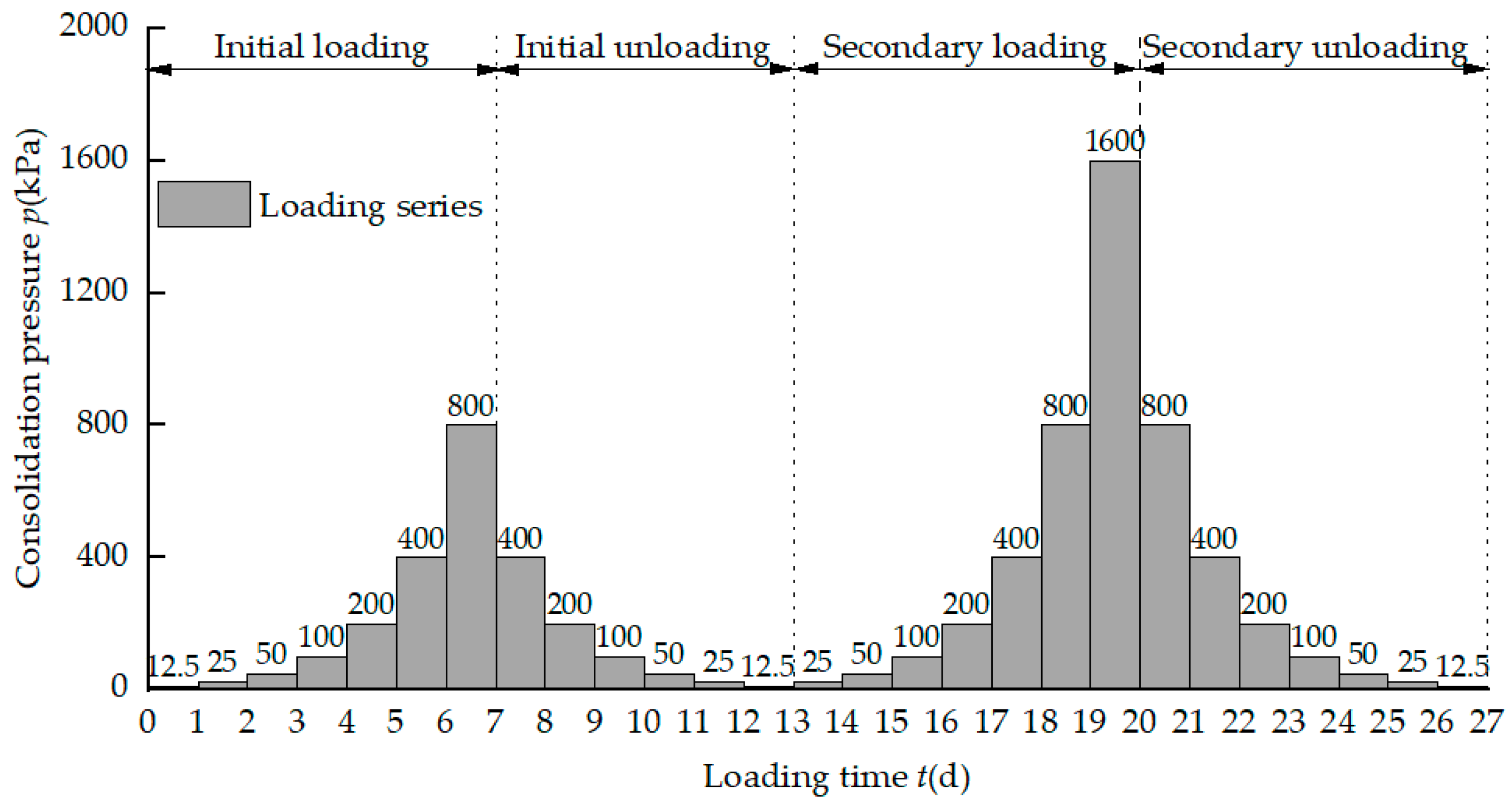
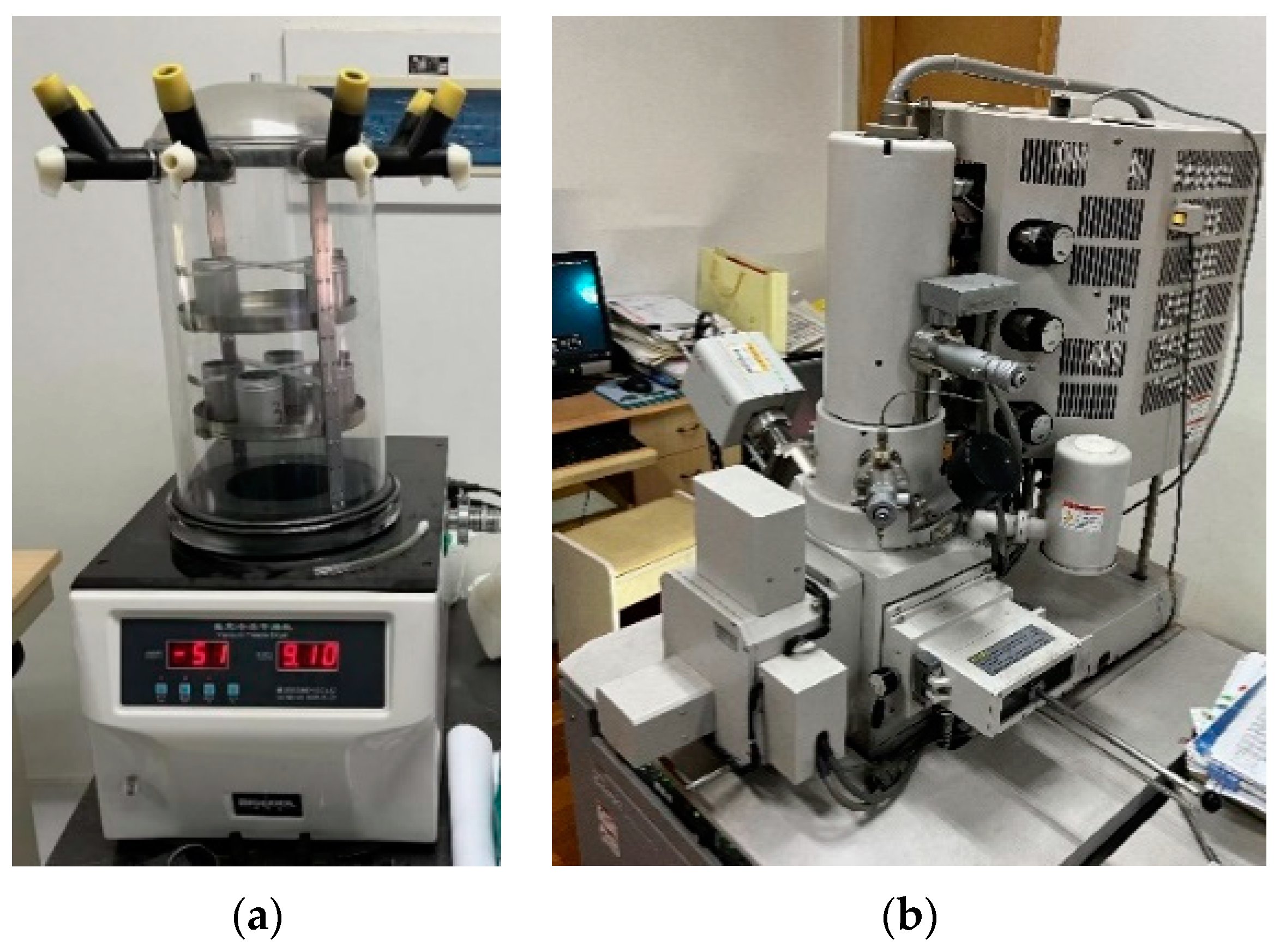
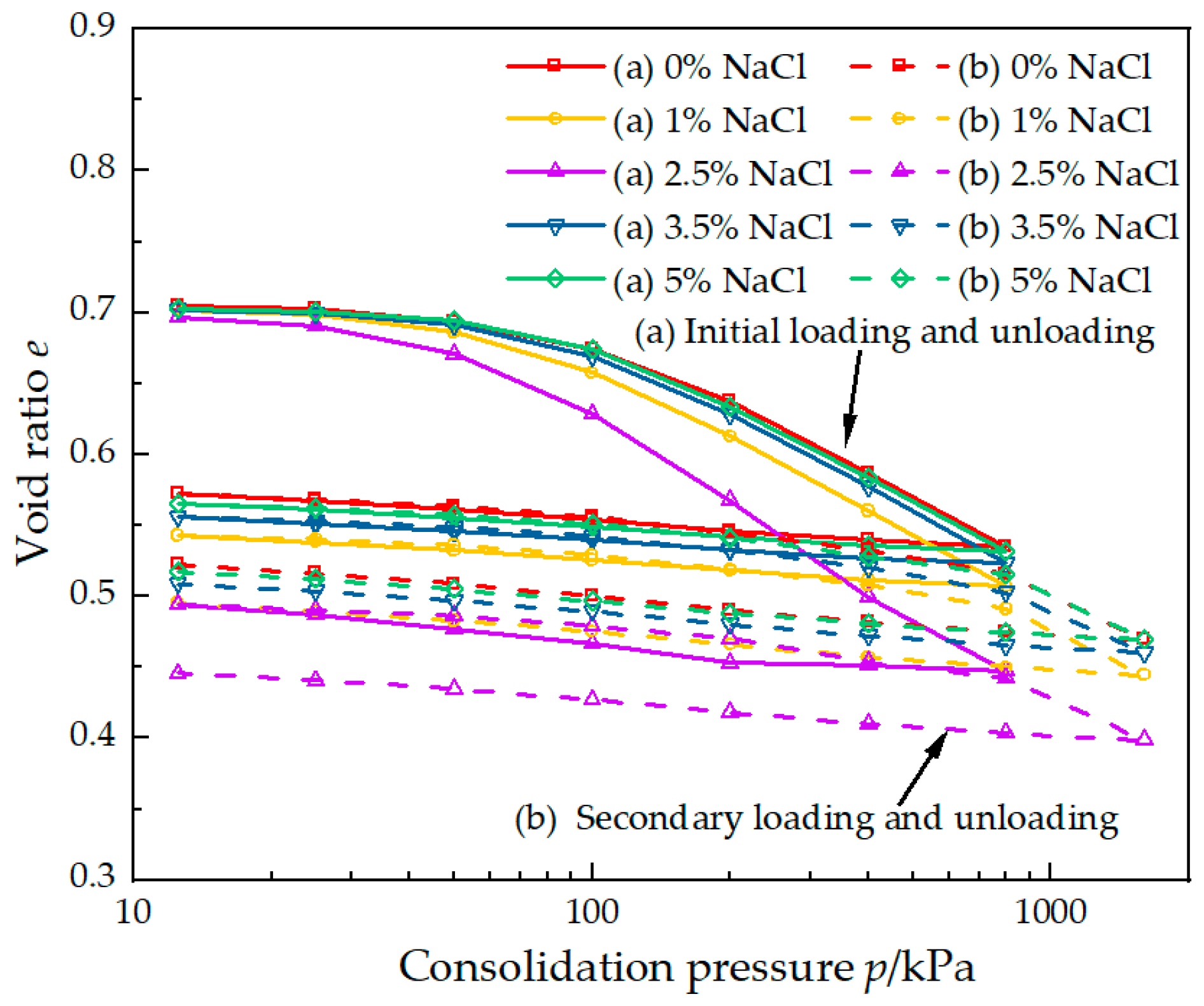
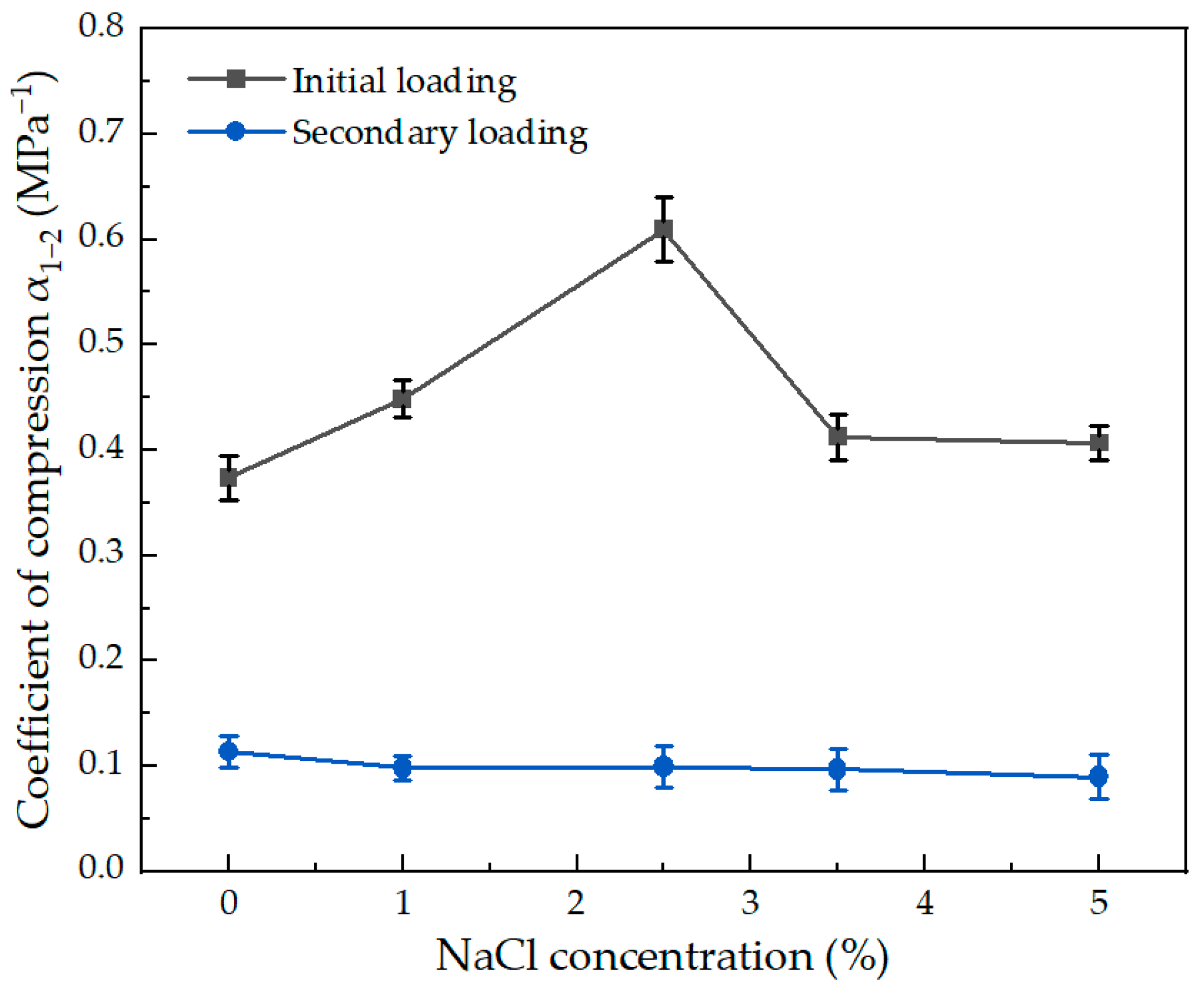
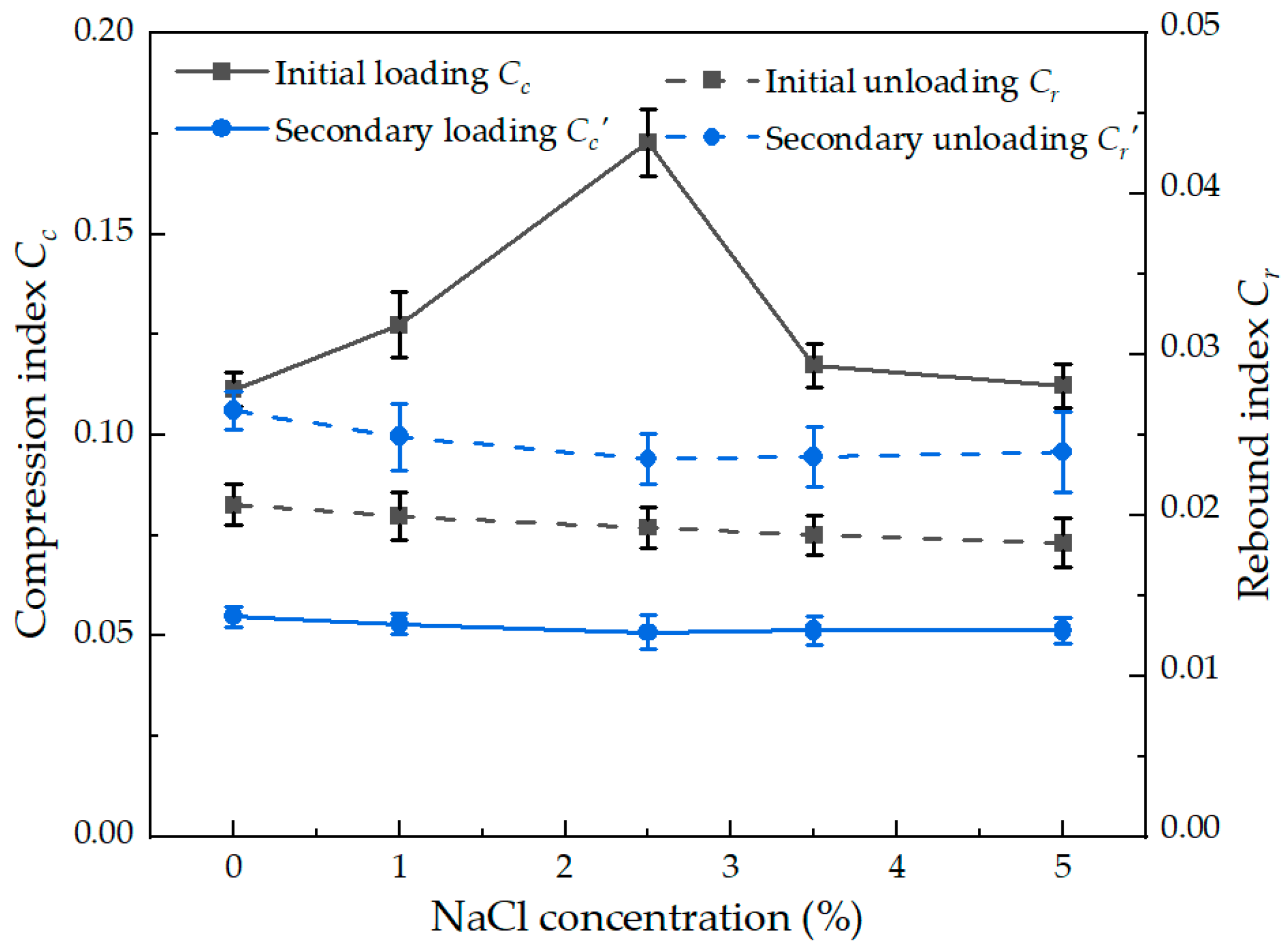
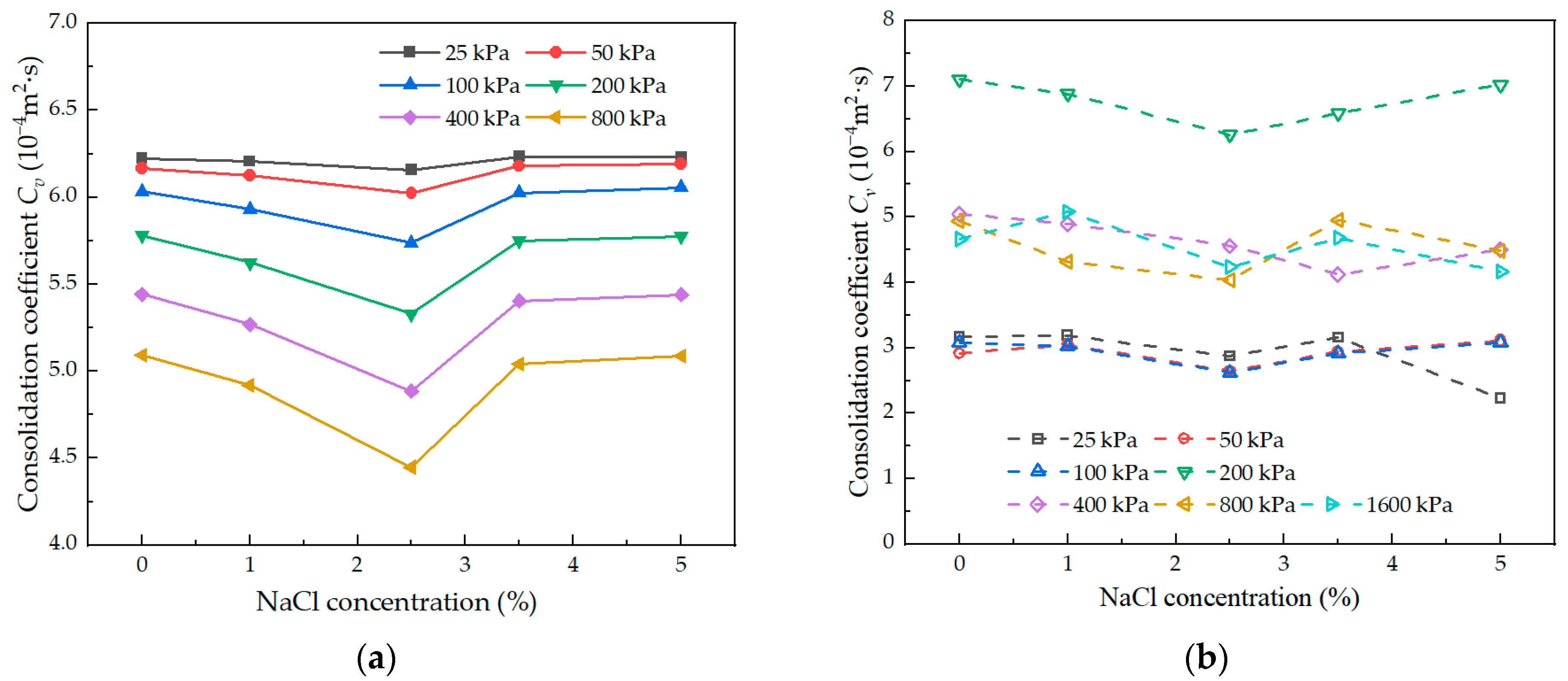
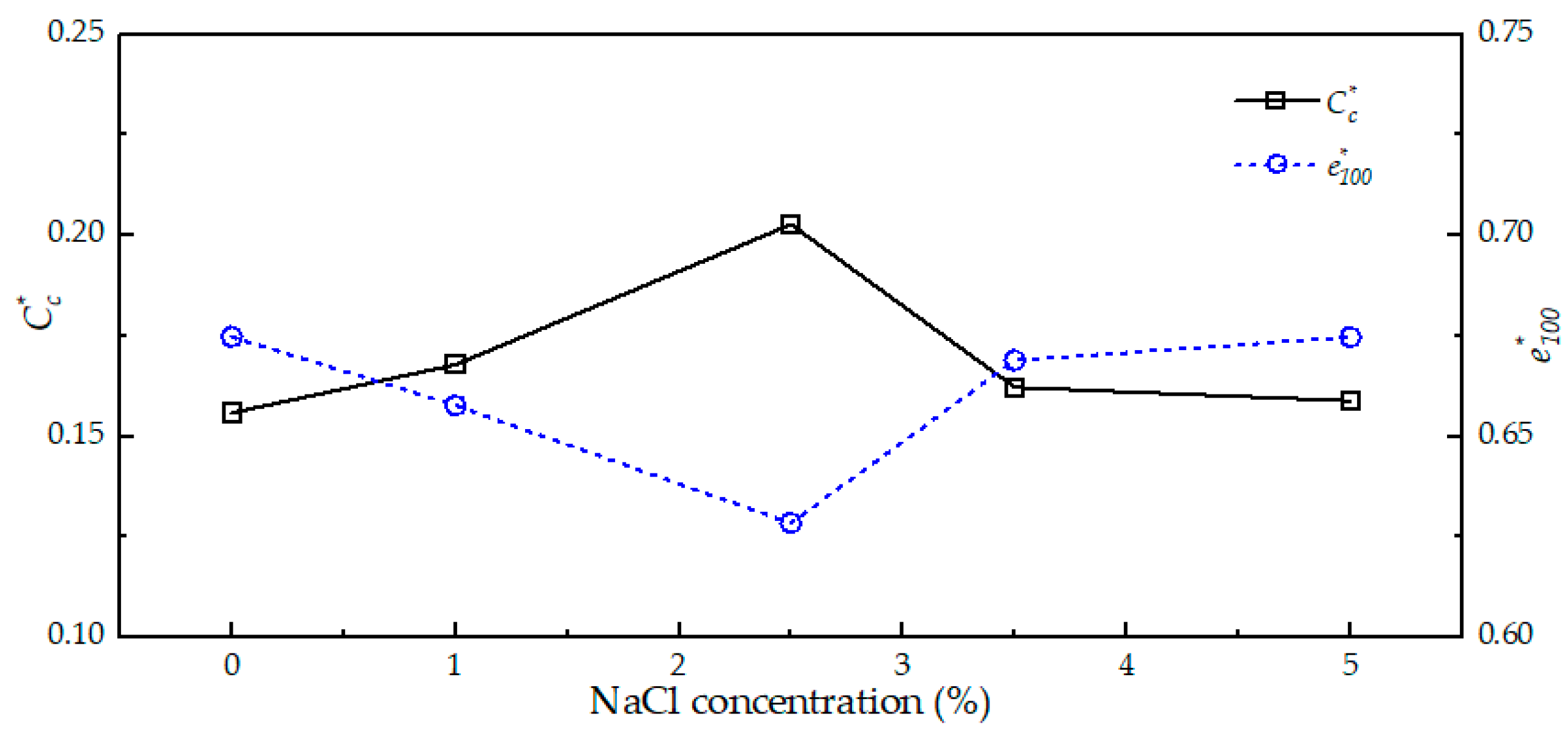
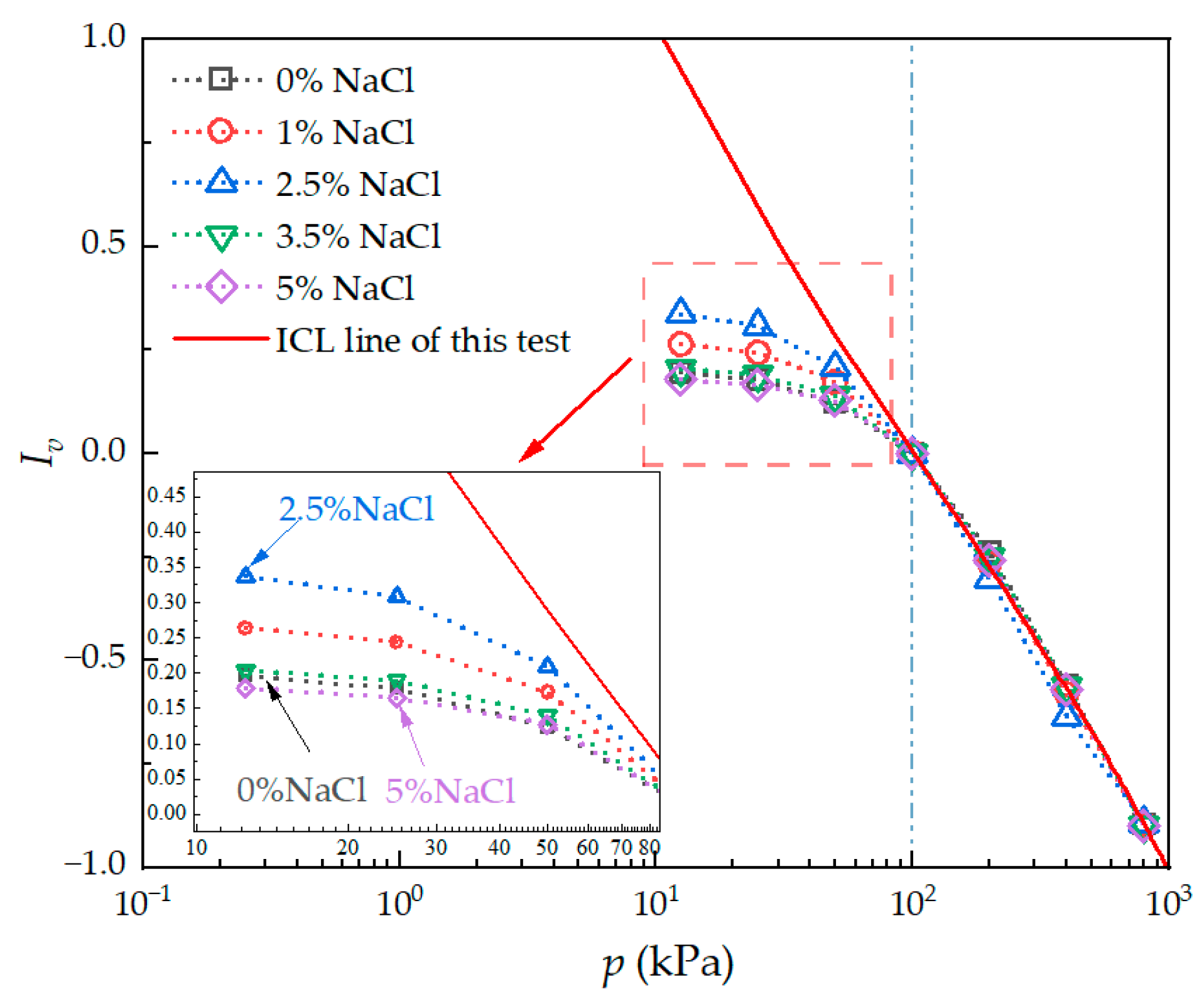

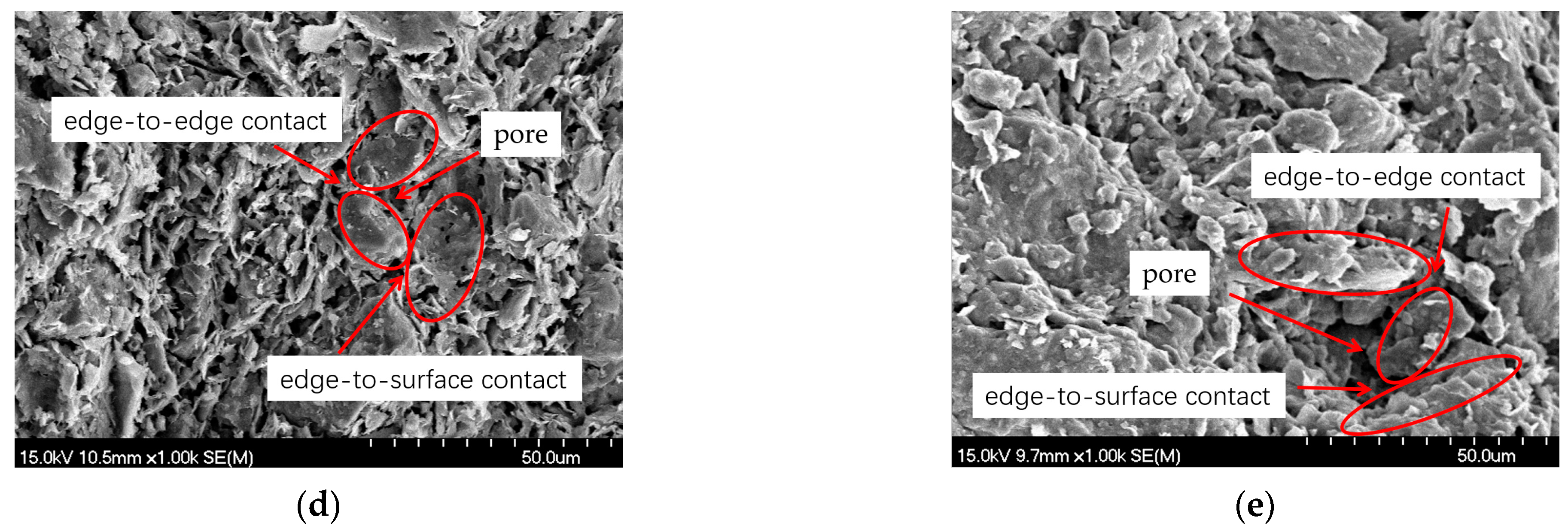

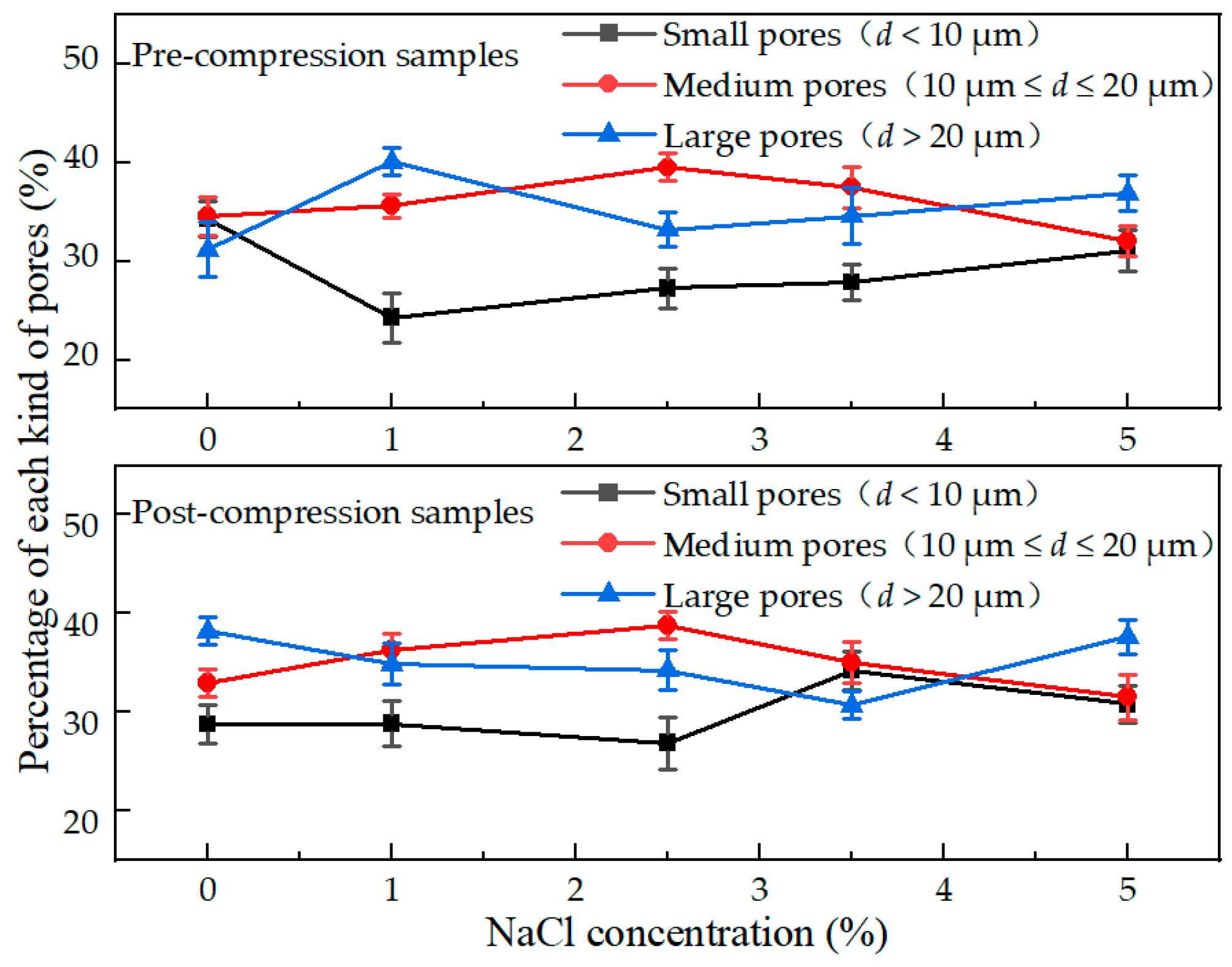
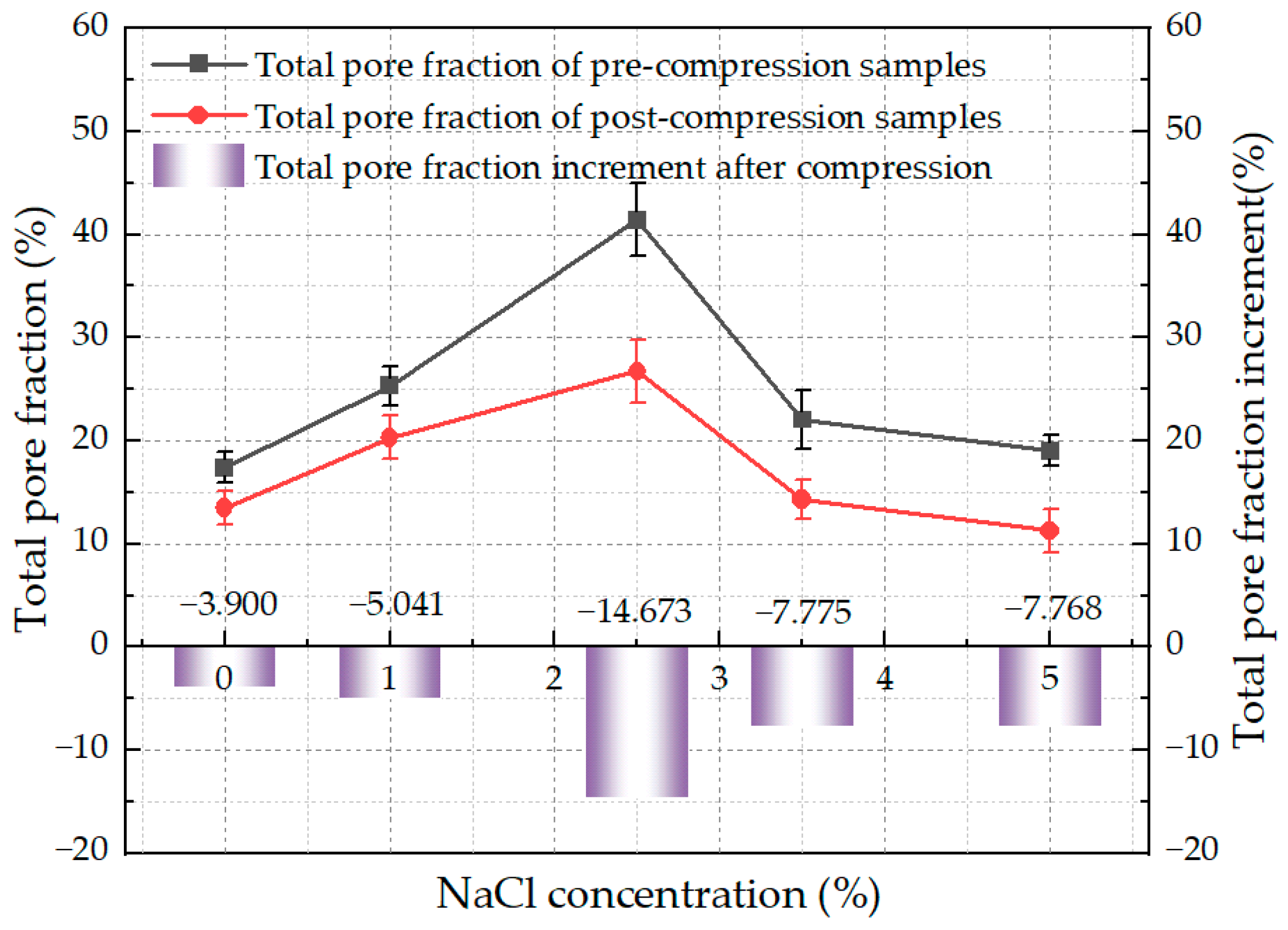
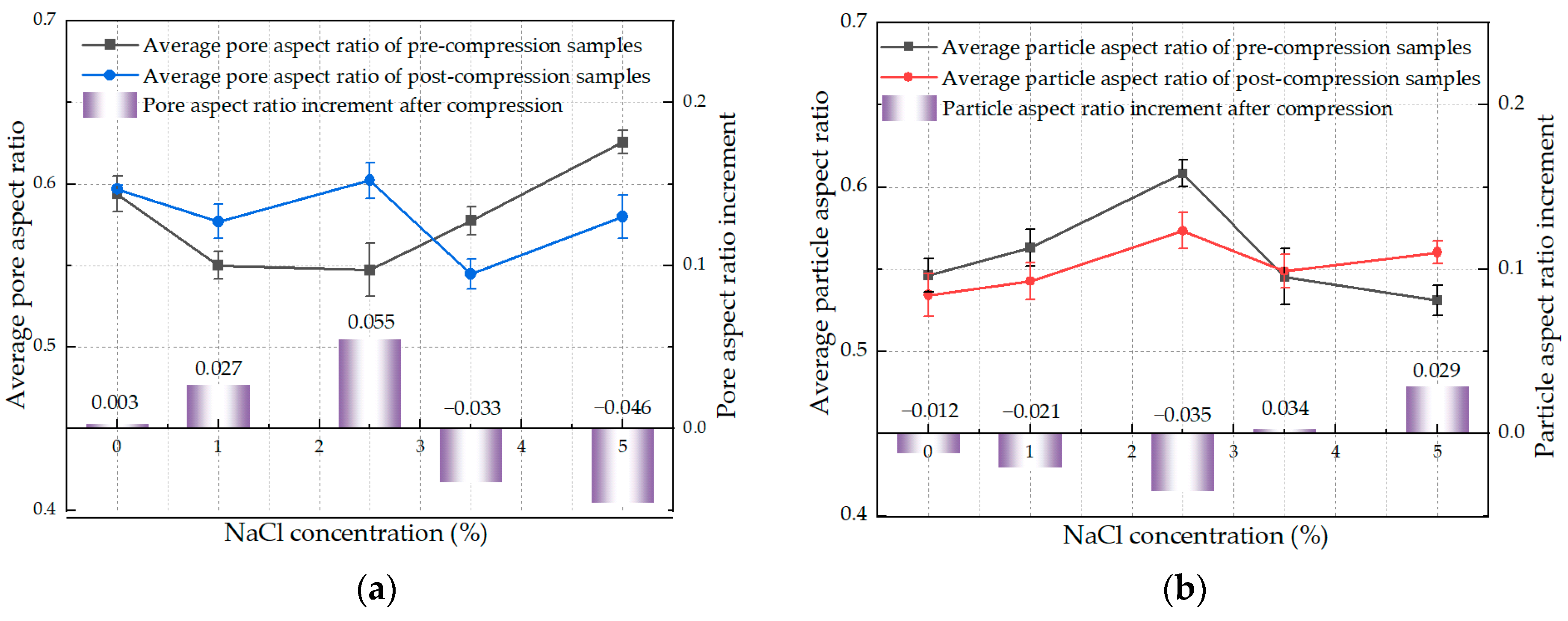
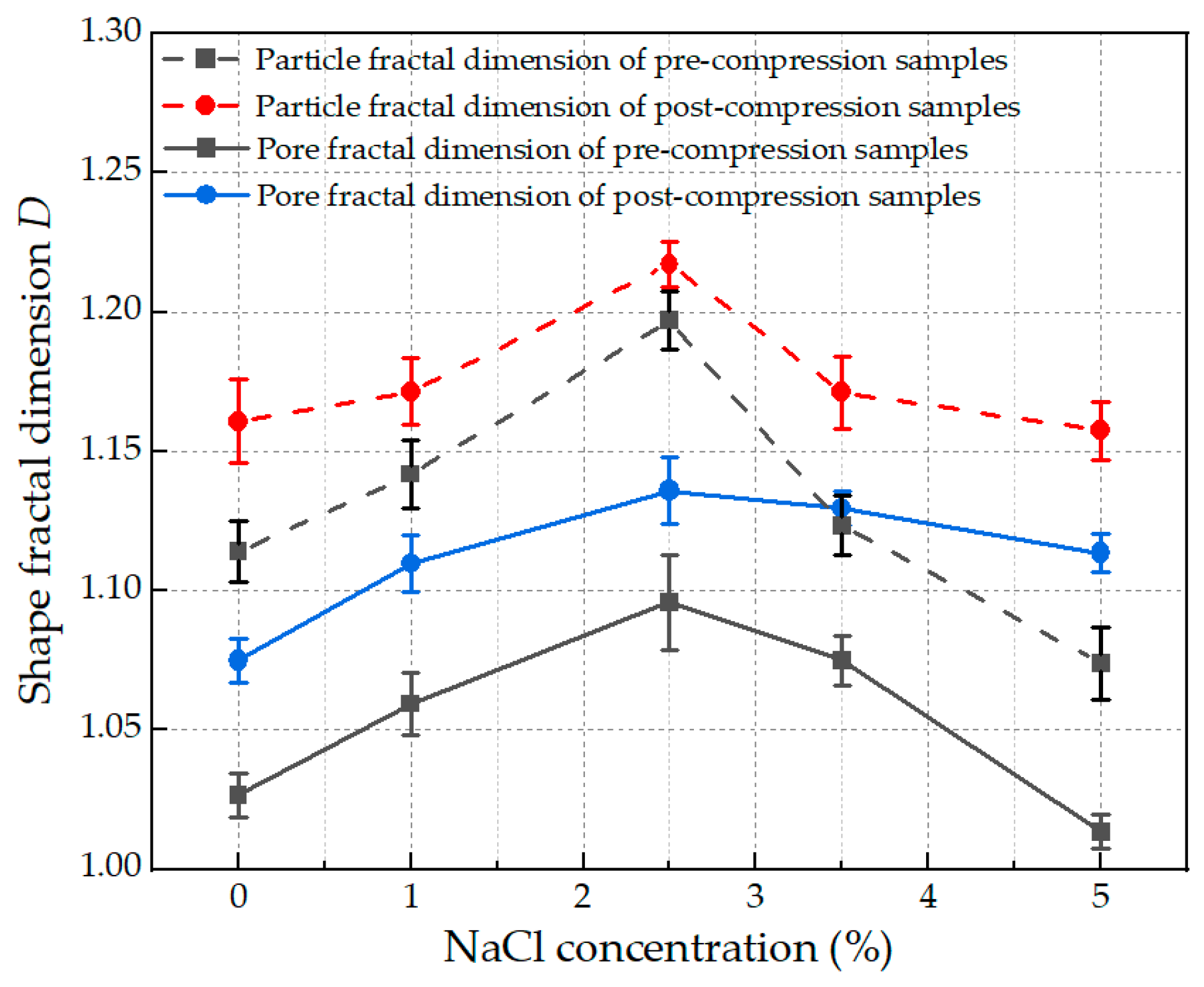
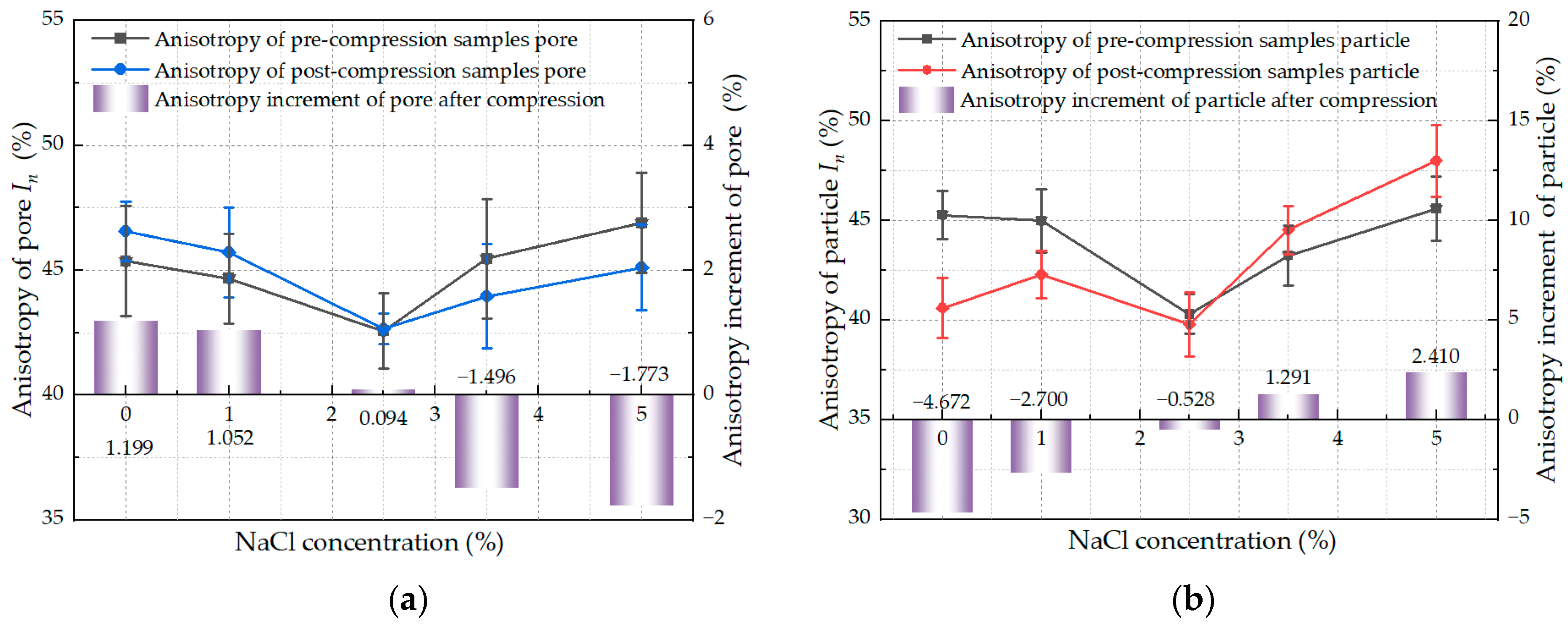
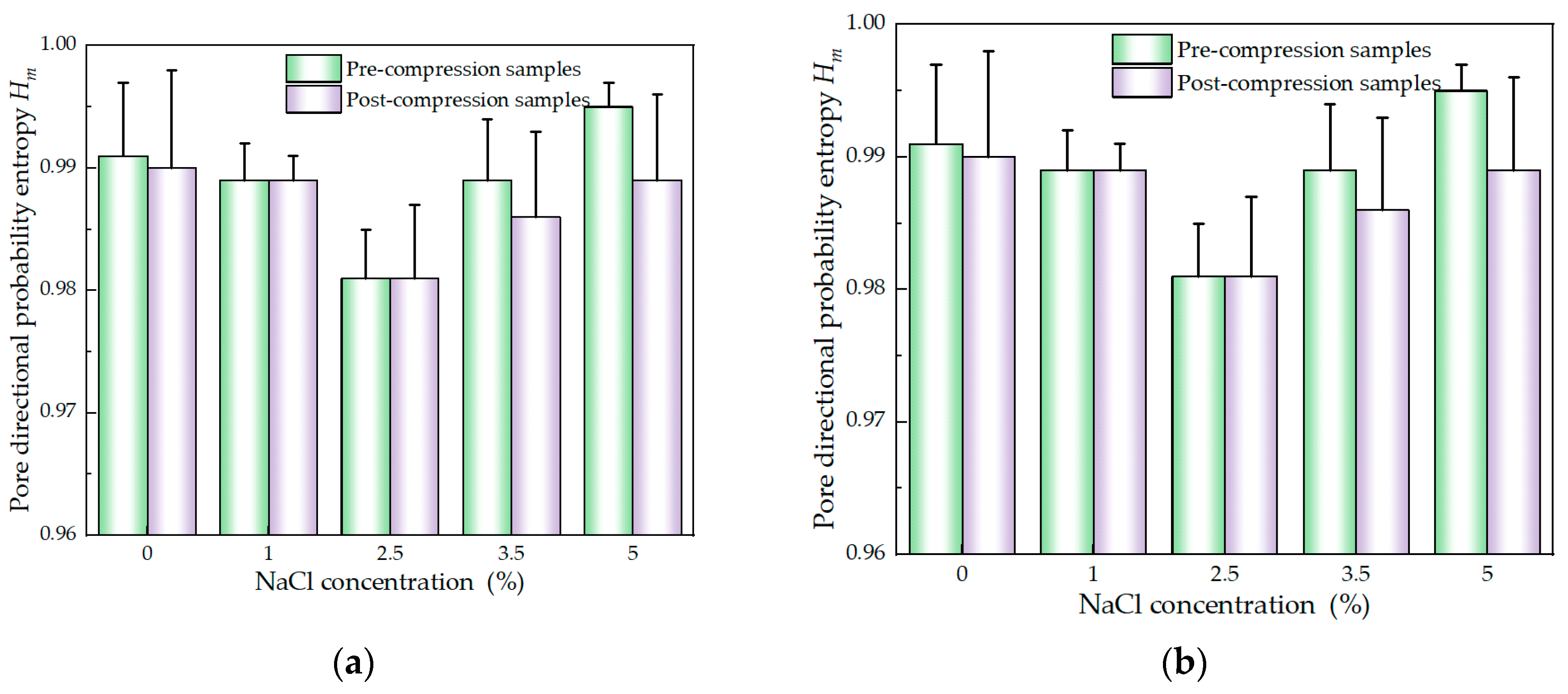

| Depth (m) | Pore Water Salt Concentration (%) | Natural Water Content (%) | Natural Density (g·cm−3) | Specific Gravity | Void Ratio | Liquid Limit (%) | Plastic Limit (%) | Plasticity Index |
|---|---|---|---|---|---|---|---|---|
| 67.0–68.0 | 0.204 | 23.74 | 1.93 | 2.66 | 0.71 | 38.21 | 15.76 | 22.45 |
| Whole Rock Mineral | Content (%) | Clay Mineral | Content (%) |
|---|---|---|---|
| Quartz | 52.2 | I/S | 62 |
| Potassium feldspar | 1.8 | It | 26 |
| Plagioclase | 10.5 | Kao | 5 |
| Hornblende | 0.7 | C | 7 |
| Clay mineral | 34.8 |
| Anion | Content (mg·L−1) | Cation | Content (mg·L−1) | Total Salinity | pH Value |
|---|---|---|---|---|---|
| F− | 1.41 | Li+ | 0.34 | 34,120 | 8.13 |
| Cl− | 13,416.62 | Na+ | 8502.19 | ||
| Br− | 10.80 | NH4+ | 0 | ||
| NO3− | 4.48 | K+ | 354.47 | ||
| SO42− | 16.4 | Mg2+ | 1022.2 | ||
| Ca2+ | 362.38 | ||||
| Total | 13,449.71 | Total | 10,241.57 |
Disclaimer/Publisher’s Note: The statements, opinions and data contained in all publications are solely those of the individual author(s) and contributor(s) and not of MDPI and/or the editor(s). MDPI and/or the editor(s) disclaim responsibility for any injury to people or property resulting from any ideas, methods, instructions or products referred to in the content. |
© 2025 by the authors. Licensee MDPI, Basel, Switzerland. This article is an open access article distributed under the terms and conditions of the Creative Commons Attribution (CC BY) license (https://creativecommons.org/licenses/by/4.0/).
Share and Cite
Zhang, Y.; Xu, H.; Wang, X.; Lv, T.; Hu, M.; Wu, S.; Sun, M. Influence of NaCl Concentration on Compression Characteristics of Marine Soil and Micro-Mechanism Analysis. Appl. Sci. 2025, 15, 5110. https://doi.org/10.3390/app15095110
Zhang Y, Xu H, Wang X, Lv T, Hu M, Wu S, Sun M. Influence of NaCl Concentration on Compression Characteristics of Marine Soil and Micro-Mechanism Analysis. Applied Sciences. 2025; 15(9):5110. https://doi.org/10.3390/app15095110
Chicago/Turabian StyleZhang, Yong, Hangbo Xu, Xinghu Wang, Tongwei Lv, Minyun Hu, Shuaifeng Wu, and Miaojun Sun. 2025. "Influence of NaCl Concentration on Compression Characteristics of Marine Soil and Micro-Mechanism Analysis" Applied Sciences 15, no. 9: 5110. https://doi.org/10.3390/app15095110
APA StyleZhang, Y., Xu, H., Wang, X., Lv, T., Hu, M., Wu, S., & Sun, M. (2025). Influence of NaCl Concentration on Compression Characteristics of Marine Soil and Micro-Mechanism Analysis. Applied Sciences, 15(9), 5110. https://doi.org/10.3390/app15095110






